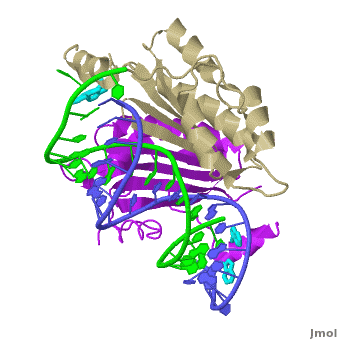Suppression of RNA Silencing by Viruses
From Proteopedia
Background
Andrew Z. Fire and Craig C. Mello shared the 2006 Nobel Prize in Medicine or Physiology for their discovery of RNA interference - gene silencing by double-stranded RNA.
RNA interference (RNAi) (also known as post-transcriptional gene silencing (PTGS) or RNA silencing) is an evolutionarily conserved cellular response to the presence of double-stranded (ds) RNA that functions as a gene inactivation system in many eukaryotes and relies on tiny RNAs as the targeting molecules. One function of RNA silencing is to act in surveillance against molecular parasites, such as viruses, several of which rely on double-stranded RNA for replication. Viruses have developed mechanisms to counteract RNAi by providing proteins that sequester the tiny silencing RNAs (siRNAs) targeted against viral RNAs.
For a general introduction to RNA interference, see the pertinent section in Molecular Biology of the Cell by Alberts et al. or the Howard Hughes Medical Institute interactive online resource on the RNAi mechanism and overview of key scientific findings or an animation from Nature Publishing Group on the mechanism of RNA Interference.
Several structures highlighted below have provided insight into the basis for the molecular interactions involved in suppression of gene silencing (RNAi) by plant and animal viruses.
Related Structures and Topics
|
|
|
- Plant Viral Protein p19 Suppression of RNA Silencing
- Tomato aspermy virus protein 2b Suppression of RNA Silencing
- Flock house virus B2 protein Suppression of RNA Silencing
- 1rpu Carnation italian ringspot virus p19 bound to siRNA
- 1r9f Tomato bushy stunt virus p19 bound to siRNA
- 2zi0 Tomato aspermy virus protein 2b bound to siRNA
- 2az0 Flock house virus B2 protein bound to double-stranded RNA (dsRNA)
- 2b9z Flock house virus B2 protein solution structure
Proteopedia Page Contributors and Editors (what is this?)
Alexander Berchansky, Wayne Decatur, Michal Harel, David Canner, Joel L. Sussman




